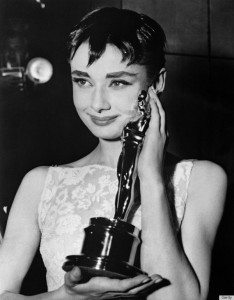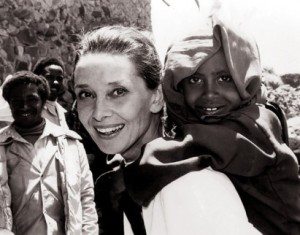The Other Audrey Hepburn
On the 4th of May the world (okay, probably not the whole world, but a bunch of dedicated film lovers) celebrated the 85th anniversary of the one and only Audrey Hepburn. Google even dedicated a doodle to the occasion (you can see it here: http://www.google.com/doodles/audrey-hepburns-85th-birthday).
The history of film saw many faces of Hepburn. The naïve and mischievous look of Princess Anna in Roman Holiday (ah, those rides on a Vespa alongside Gregory Peck), the doe-like grace and child-like innocence of Sabrina Fairchild – as a contrast to Humphrey Bogart’s cynical Linus Larrabee in Sabrina, and, finally, the iconic image of Hepburn, emerging from a yellow taxi to a deserted New York morning and surveying the window of Tiffany’s, dressed in a sleek black Givenchy dress and wearing massive shades. Wrapped in style, eccentricity and mind-blowing naïvety, Hepburn’s Holly Golightly is easily the actress’ most identifiable and iconic role; and possibly one of the most memorable film roles of all time.
Throughout her career Hepburn was nominated for five Oscars and won one, for her work in Roman Holiday.She is perhaps most recognised as an icon of style rather than an actress, however, this does not devalue her excellence at acting.
Yet yesterday, on the day of her birthday, I realised that I am quite disappointed that a woman, who was the first one to win the golden trio – a BAFTA, an Oscar and a Golden Globe – for a single performance (Roman Holiday, Seriously, go see it), mainly remembered just for being beautiful.She won a Tony award for Best Lead Actress in a Play for Ondine; and moreover, she remains one of the few people who have won an Oscar, an Emmy, a Grammy and the mentioned Tony. Quite a collection.
Having achieved stardom and fame, Hepburn devoted more energy to humanitarian pursuits than artistic ones. She was appointed the Goodwill Ambassador of UNICEF, and, after her death in 1993, was awarded the Jean Hersholt Humanitarian Award for her contribution to humanity. Furthermore in 2002, UNICEF honoured her legacy by unveiling a statue ‘the Spirit of Audrey’ outside their New York headquarters.
Hepburn’s first humanitarian trip was the 1988 journey to Ethiopia, where she visited an orphanage in Mek’ele that housed 500 starving children. After the trip she commented, “I have a broken heart. I feel desperate. I can’t stand the idea that two million people are in imminent danger of starving to death, many of them children, [and] not because there isn’t tons of food sitting in the northern port of Shoa. It can’t be distributed. Last spring, Red Cross and UNICEF workers were ordered out of the northern provinces because of two simultaneous civil wars… I went into rebel country and saw mothers and their children who had walked for ten days, even three weeks, looking for food, settling onto the desert floor into makeshift camps where they may die. Horrible. That image is too much for me. The ‘Third World’ is a term I don’t like very much, because we’re all one world. I want people to know that the largest part of humanity is suffering.”
This was three years after Live Aid and the world had already turned its eyes towards developing countries. Yet to me it seems beautiful that Hepburn was not drawing a distinction between ‘us, the West’, and ‘them, the Third World’, emphasising the oneness of the world as a whole.
Afterwards, Hepburn travelled to Turkey, Venezuela, Ecuador, Central America, Sudan, Bangladesh, Vietnam, and her last trip – four months before she died – was to Somalia. Even though she was horrified by the famine and tragedy she witnessed, she still had hope: “Taking care of children has nothing to do with politics. I think perhaps with time, instead of there being a politicisation of humanitarian aid, there will be a humanisation of politics”.
Obviously, nowadays it is quite fashionable to make pilgrimages to developing countries and loudly proclaim support for their welfare; yet Hepburn’s humanitarian work seems pioneering, consistent, and, most importantly, truthful. In an interview, she claimed that the people of, let’s say, Sudan, do not know what Audrey Hepburn is, however, they do know UNICEF. And thus she visited these countries not as the great actress and fashion icon, but as an ambassador.
So every time I see Audrey Hepburn’s legacy reduced to a cheeky Holly Golightly, I sigh. Hepburn was so much more than just a pretty woman.




Comments